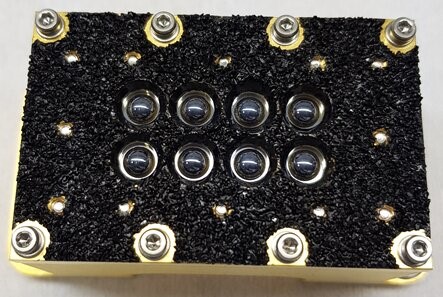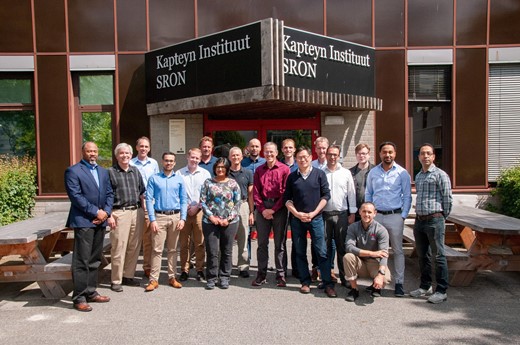Source: SRON Netherlands Institute for Space Research

The first 4.7 THz detector array for the GUSTO mission. Each sphere in the center is one pixel, creating an 8-pixel-array. Credit: SRON Netherlands Institute for Space Research
The first detector array for NASA's GUSTO mission has passed its pre-shipment review and is now shipping to the University of Arizona for integration into the balloon observatory. SRON together with TU Delft develops GUSTO's three 8-pixel-arrays, for the frequencies 4.7, 1.9 and 1.4 terahertz. They have now finished the array for the 4.7 terahertz channel―the most challenging part. GUSTO is a balloon mission that will measure emissions from cosmic material between stars.
NASA's Galactic/extragalactic ULDB Spectroscopic Terahertz Observatory (GUSTO) is a balloon observatory that will drift in the Earth's atmosphere for over 75 days at the edge of space, at a 36-km altitude. The launch is scheduled for December 2021 from Antarctica. The observatory consists of a telescope of 1 meter in diameter and three observation instruments carried by an ultra-long duration balloon (ULDB). It contains three array receivers for electromagnetic radiation of 1.4, 1.9, and 4.7 terahertz. The GUSTO team has now delivered its first array―for the 4.7 terahertz channel. This is the most challenging to realize because it requires the highest sensitivity and most precise pointing of the lens-antenna beam. The design, manufacture, assembly and testing of the array were carried out at SRON, while the superconducting detectors were developed at TU Delft.
GUSTO has three channels to map respectively ionized nitrogen (NI), carbon (CII), and oxygen (OI) emission lines in the spectrum of the interstellar medium―the material floating in between stars. This helps scientists to determine the life cycle of interstellar gas in our Milky Way, witness the formation and destruction of star-forming clouds and understand the dynamics and gas flow in the vicinity of the center of our galaxy.
Delivering the first array is the result of an international collaboration involving SRON, TU Delft, University of Arizona and NASA.

Most of the GUSTO team members, including some US colleagues, during the Critical Design Review at SRON in Groningen. Credit: SRON Netherlands Institute for Space Research

